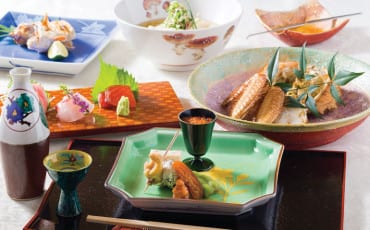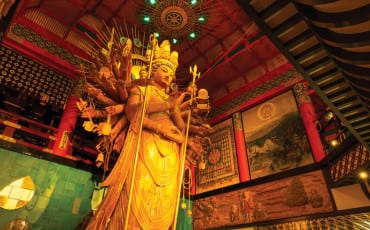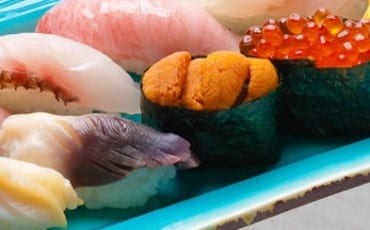- OISHII
- Articles
- Chefs Interview
- Food for the Soul
Articles
Chefs Interview
Feb 1, 2018
Food for the Soul
Kushikatsu may have humble origins, but this beloved Osaka street snack is now given a gourmet twist by these three inventive chefs.
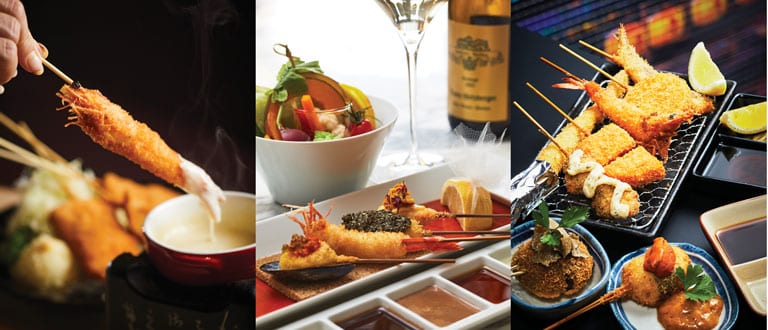
Kushikatsu is battered deep fried food served on skewers. “Kushi” refers to the bamboo skewer used, while “katsu” references the meat cutlet. It’s also known as kushiage in the eastern parts of Japan, although kushiage is a broad term that includes skewered ingredients prepared with different frying methods—for example, without panko (Japanese breadcrumbs with a light, flaky texture). Kushikatsu, however, is almost ubiquitiously prepared with panko.
Kushikatsu can be found all over Japan but it’s probably most popular in Osaka. After all, that is the city where it all began. In 1929, the proprietress of the now-legendary Daruma hit upon the idea of serving skewered meat to the local labourers who thronged her shop. Using hearty ingredients like meat, onions, and potatoes, and slathering it with a thick batter, this simple but delicious meal helped fill the bellies of hungry workers. Today, kushikatsu continues to be a favourite among the working class, but more and more upscale restaurants are serving gourmet versions of the dish.
For example, some of the typical ingredients used in kushikatsu include chicken, pork, and seasonal vegetables. However, in higher-end restaurants, kushikatsu ingredients run the gamut from prawns and scallops to premium cuts of beef. Whatever the ingredient used, the cooking style is the same—the ingredients are skewered on the kushi and dipped in a mixture of egg and flour, then put panko before being deep-fried in hot oil.
Regular kushikatsu is usually served with tonkatsu sauce but in the Nagoya area, a type of sweet miso sauce may also be served. In the upscale restaurants, however, the chefs usually prepare a variety of sauces to complement the various ingredients served.
While every chef will have his own unique take on how to prepare kushikatsu, one factor remains a constant— this is one scrumptious Japanese dish you absolutely cannot miss out on!
Tsutomu Koga
Chef, Ginza Kushi-Katsu
From the F&B group who introduced Singaporeans to popular ramen restaurant chain Ajisen Ramen and gyoza specialist Osaka Ohsho comes a brand new concept—Ginza Kushi-Katsu. They are the first in Singapore to introduce Kushi-Katsu Fondue, where you dip the skewered ingredients into a selection of piping hot sauces. Chef Koga tells us more.
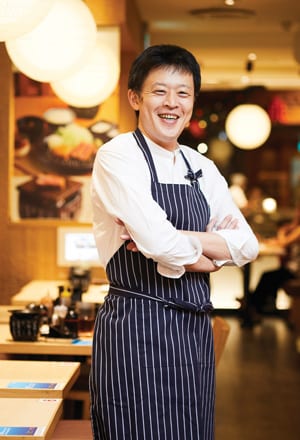 Tell us about the kushikatsu at Ginza Kushi-Katsu.
Tell us about the kushikatsu at Ginza Kushi-Katsu.
Our standard set is a popular option with customers. It comes with five skewers—pork loin (soaked in onion sauce before frying for a tender texture), prawn, Shiitake mushroom, Camembert cheese, and gyoza. Customers can choose from either a demi-glace fondue—house-made with a proprietary blend of ingredients—or a cheese fondue, also house-made with a blend of Gruyère cheese, cheddar, and white wine. As for the panko that we use to coat the ingredients, we have a special blend of extra-fine breadcrumbs mixed with our secret combination of spices.
What do you think is the secret to a good kushikatsu meal?
At Ginza Kushi-Katsu, we strive to stay true to the kushikatsu tradition in Osaka where it’s all about enjoying good food in a casual, laidback atmosphere. I believe our kushikatsu is best enjoyed with a side of alcohol, especially if you’re going for the cheese fondue option. We have several different drink options, including a sparkling sake & yuzu cocktail, but for an authentic taste of Japan, you can’t go wrong with an ice cold glass of Asahi beer.
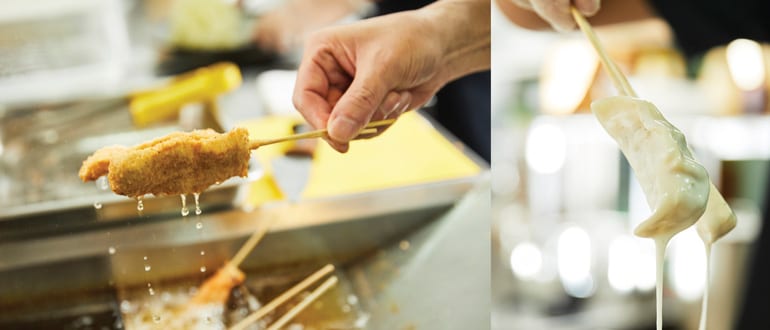
A little-known fact about yourself is that you weren’t professionally trained as a chef. Tell us more.
Yes, I actually graduated from design school and harboured ambitions of being a painter. However, I’ve always wanted to work overseas so when the opportunity to work in Singapore arose, I immediately took it. I’ve worked part-time in many different restaurants where I learned the basics but most of my culinary skills are picked up through cookbooks and speaking to chef friends. Actually, the creative process of working with different ingredients to develop a new dish is similar to being an artist!
Ginza Kushi-Katsu
#B1-47 Paragon Shopping Centre, 290 Orchard Road
Tel: 6262 1304
Hideyuki Tanaka
Head Chef, Ginza Rokukakutei Singapore
Specialising in high-end kushiage, Ginza Rokukakutei Singapore marks the famed restaurant’s first foray outside of Japan. Chef Tanaka first worked in the Ginza establishment, before being trained by the owner chef of the original restaurant, Rokukakutei in Osaka—the only kushiage restaurant in Japan to be awarded with a Michelin star.
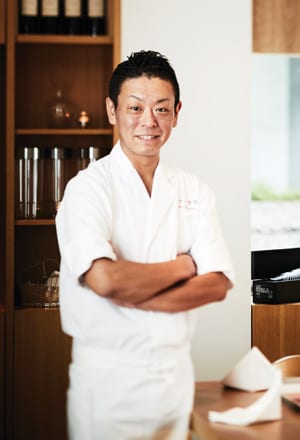 What makes the kushiage at Ginza Rokukakutei unique?
What makes the kushiage at Ginza Rokukakutei unique?
Our kushiage is not simply a deep-fried food. When we coat the ingredient with panko, we’re careful to leave a small air pocket between the batter and ingredient. When dipped in hot oil, this small gap “steams” the ingredient, which helps maintain its moistness. The combination of a crispy outer casing and moist, juicy flavours of the ingredients is simply delicious.
What are some of the most popular ingredients at your restaurant?
Some of our customers’ favourite include the mashed pea croquette as well as the shiso leaf with chicken fillet topped with donburi (vegetable caviar). To us, it’s important that we understand and respect each ingredient so as to bring out its flavours as authentically as possible.
Tell us about the condiments that accompany the kushiage.
We offer our diners a selection of condiments, such as snow salt from Miyako Island, a blend of salt and sansho pepper from Kyoto, a house-made brown wine sauce from our outlet in Osaka, a blend of sesame and mustard sauce, dashi soya sauce, and a blend of mustard and lemon sauce. When we serve the kushiage, we place the skewer towards the direction of the recommended condiment, but of course, it’s up to the diner to decide which condiment they prefer.
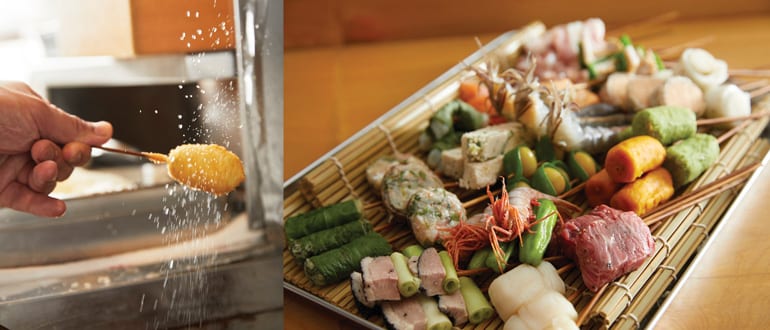
Where do you get your ingredients?
We get seafood from Tsukiji Market in Tokyo twice a week, vegetables from Hokkaido once a week, and a variety of fresh ingredients from Osaka twice a week.
What can diners expect from a meal at Ginza Rokukakutei?
Another unique aspect of our restaurant is how we offer wine pairings with our kushiage. We have a wide selection of fine wines from around the world.
Ginza Rokukakutei Singapore
#01-04, Odeon Towers, 331 North Bridge Road
Tel: 6266 1077
Kazuma Ishikawa
Head Chef, Panko Restaurant & Bar
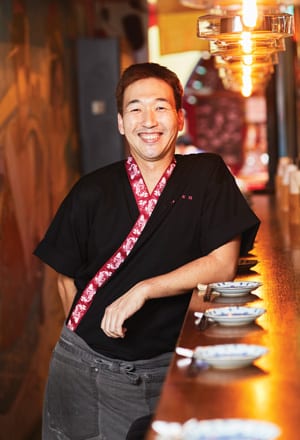 With over 20 years’ experience working in Japanese restaurants, including a stint at the prestigious Hide Yamamato in Marina Bay Sands, Chef Ishikawa is a seasoned pro when it comes to creating inventive new dishes.
With over 20 years’ experience working in Japanese restaurants, including a stint at the prestigious Hide Yamamato in Marina Bay Sands, Chef Ishikawa is a seasoned pro when it comes to creating inventive new dishes.
What makes the kushikatsu at Panko unique?
Apart from having a wide selection of kushikatsu (15 variants), we are also a stickler for details when it comes to the ingredients we use. For example, we get our panko specially customised in Japan in order to achieve our desired texture and size of grain. The oil we use is a blend of four oils – olive oil, soybean oil, and two kinds of sesame oil. This particular blend has a light, subtle fragrance and flavour; it’s not too heavy on the palate.
Tell us about some of the signature dishes at Panko.
The Assorted Kushikatsu Set—which comes with asparagus, onion, pumpkin, prawn, chicken, and shishamo—is available for lunch, and is especially popular with the office crowd. Other signature dishes on the a-la-carte menu include the scallop topped with uni served with an espuma of shoyu and dashi, and the shiitake mushroom served with minced chicken paste and topped with tori (chicken) miso paste and sliced truffles.
What sort of condiments do you serve at Panko?
We have a homemade kushikatsu sauce, which is made with a blend of tonkatsu sauce, shoyu, and Japanese Worcestershire sauce. Our homemade ponzu sauce is made using yuzu juice, shoyu, mirin, and katsuboshi, Japanese pink sea salt from Seto Inland Sea, and fresh lemon.
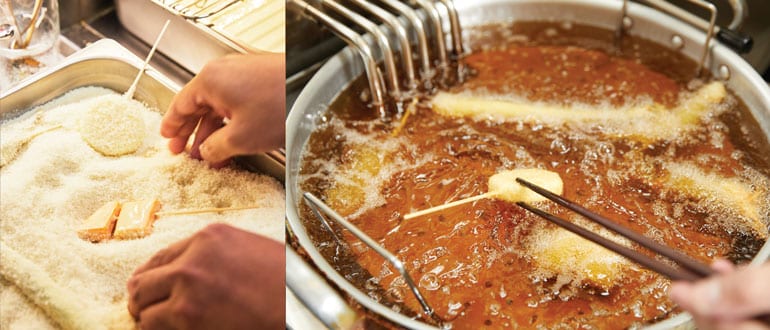
What is your secret to preparing delicious kushikatsu?
It’s important to coat each ingredient evenly with panko so that it’s evenly cooked on all sides and so that the batter doesn’t detach during the frying process. We also spin the skewer while frying to ensure the ingredient is rid of excess oil.
What can diners expect from a meal at Panko?
Panko offers an authentic kushikatsu experience, complete with a fun, laidback atmosphere. To complement our selection of kushikatsu, we serve a wide variety of imported Japanese alcoholic beverages that you’ll probably not find elsewhere in Singapore.
Panko Restaurant & Bar
4 Haji Lane (or 33 Arab Street)
Tel: 6291 3323





